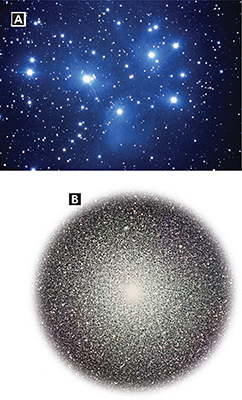In 1650, the Italian astronomer Giovanni Baptista Riccioli used a telescope like the one shown in Figure 20 to observe Mizar and Alcor, a double star in the Big Dipper. He saw that Mizar itself was two stars that were very close together. This was the first of thousands of star systems to be discovered. A star system is a group of two or more stars that are held together by gravity.  Astronomers have determined that more than half of all stars are members of star systems. A star system with two stars is called a binary star. The two stars orbit each other, held together by gravity.
Astronomers have determined that more than half of all stars are members of star systems. A star system with two stars is called a binary star. The two stars orbit each other, held together by gravity.
Sometimes the smaller star in a binary star is too dim to be seen easily from Earth, but can still be detected from the motion of the other star. The bright star Sirius A, for example, wobbles back and forth. Astronomers have discovered that this wobble is caused by the gravitational pull of a faint companion star, Sirius B. In some binary star systems, one star passes in front of the other, blocking some of the light from reaching Earth. Such a star system is called an eclipsing binary. The brightness of an eclipsing binary varies over time in a regular pattern.
Star Clusters
In the winter sky, you can see a faint group of stars called the Pleiades, shown in Figure 21A. Studying star clusters is useful because all the stars formed together in the same nebula. Therefore, they are about the same age and the same distance from Earth. Astronomers plot the stars of a cluster on an H-R diagram to estimate the cluster's age.
Figure 21 Open clusters contain young blue stars, which are usually absent in globular clusters. A The Pleiades are an open star cluster that is visible to the unaided eye. B 47 Tucanae is a spectacular globular cluster that is visible in southern skies.
Comparing and Contrasting Use these photos to describe the differences between open clusters and globular clusters.

 There are three basic kinds of star clusters: open clusters, associations, and globular clusters. An open cluster, like the Pleiades, has a disorganized or loose appearance and contains no more than a few thousand stars that are well spread out. Open clusters often contain bright supergiants and gas and dust clouds. Associations are temporary groupings of bright, young stars. In time, gravity from nearby stars breaks these groups apart. Associations are typically larger than open clusters.
There are three basic kinds of star clusters: open clusters, associations, and globular clusters. An open cluster, like the Pleiades, has a disorganized or loose appearance and contains no more than a few thousand stars that are well spread out. Open clusters often contain bright supergiants and gas and dust clouds. Associations are temporary groupings of bright, young stars. In time, gravity from nearby stars breaks these groups apart. Associations are typically larger than open clusters.
In contrast, a globular cluster is a large group of older stars. Globular clusters usually lack sufficient amounts of gas and dust to form new stars. They are spherical and have a dense concentration of stars in the center, as shown in Figure 21B. Globular clusters can contain more than a million stars. Globular clusters usually do not have short-lived blue stars because these stars have already died out. If Earth revolved around a star in the middle of a globular cluster, the night sky would blaze with the light from thousands of bright stars. Astronomers estimate that the oldest globular clusters are about 12 billion years old. Thus, the universe must be at least that old.




